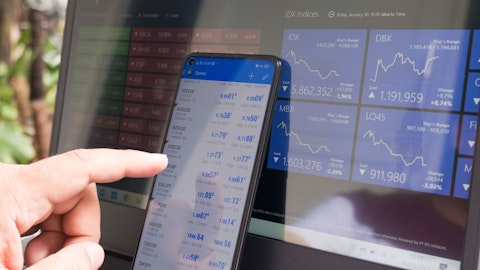So I think that composition is exactly kind of the building block into 2024. Again, there’s always going to be the ebbs and flows of when a new flagship comes in or when we launch on a new platform, but I think we do feel like we’re in a good place heading into 2024 in the balance between products and between channels. And wealth continues to be strong for us and institutional continues to be strong. We’ve seen some of those SMAs. We’ve long talked about start to actually convert and credit, and those are big chunky numbers as well.
Alex Blostein : Great. Thank you. And then one strategic question for you guys, actually, a bit of a two-parter, but I promise they’re sort of related. On the balance sheet, so you mentioned insurance and you guys are looking to explore insurance opportunities for the firm. How do you think about structuring that? How do you think about minority ownership, majority ownership insurance companies that’s kind of part one. And again, sort of related to the balance sheet, I saw you guys launched taking minority stakes with an asset manager and Abu Dhabi, maybe a little counterintuitive just given the fact that, that’s what Dyal sort of does, obviously, a bigger scale. But why not do the strategy out of GP Solutions? What’s the strategy behind partnering and doing a JV? Thanks.
Marc Lipschultz: Sure, and appreciate both questions. So, first, with regard to insurance, look, it’s an area that we have been for years, spending time on trying to develop a appropriate strategy. So let’s start with this. We have two terrific channels of capital access that we talked about today, wealth and institutional, traditional institutional. The one we don’t have that, obviously, some of our peers have done so well with is insurance. We’re aware of that. We’ve been working on that pretty thoughtfully. We may not be able to develop the right solution, but it’s something we’re focused on adding to bring that third key leg in that again, most others have developed. From our point of view, we’re going to stay true to our strategy.
Look, we are in the asset management business. We are balance sheet light. Both of those will remain our focus. We do not aspire to own an insurance company, we aspire to become an insurance company, people have different strategies, so we’re not opining on anybody else’s strategy have been enormously successful for other people. That’s not our strategy. So, our strategy is much more about how do we access asset management the insurance channel in a balance sheet light way. So that’s really where our focus is. And it will continue to be an intense focus, maybe an ever more intense focus, as we head into 2024. And as we’ve now really gotten our other acquisitions integrated, and you can see kind of the cylinders firing in the fourth quarter.
With regard to — sorry, what was your second question? Oh, yes, the Luna JV.
Alex Blostein : Luna JV.
Marc Lipschultz: Yes. So just to be clear on the architecture, this is part of our GP solutions product and back to this point about having adjacencies that are highly strategic and additive where we can add value for our investors in a distinct way. So today, as you know, we really are the market for large cap GP solutions. And in fact, that fund very much by design, focuses on large cap managers, the CBCs, the Veritas, the Silver Lakes. And so that’s been an area where we’ve built a distinct network. We have our BSP, our operational support resources. And we love that space. And of course, we’re in with our flagship where we got off to a good start in the fourth quarter. There’s another arena that has not been our focus, which are these more higher — well, it may not be higher growth actually because those firms we grow quite substantially.
But younger firms or smaller firms that have a lot of ongoing potential or the so-called middle market. So hence, our advantage fund in combination with Lunate is our way of coming with a value-added solution to that market. In all our markets, again, I’ll anchor back to what do we want to get paid for. We’re going to get paid for delivering outstanding risk-adjusted results, you have to have a value proposition for that. Well, we are now coming to the middle market, so to speak, the growing marketplace there, and we’re delivering two things with this partnership that are very distinctive. We’re delivering our capabilities as, by far, the largest investor in GPs and the entire network that brings with it. And the operational resources, which are — certainly been valuable to many of our large cap GPs, but think about the value and impact of those resources to a firm that can’t afford to hold all those themselves, right?
If you manage $50 billion, $100 billion you can have a whole lot of operational capabilities in-house. But when we manage $5 billion and growing our ability to bring our BSP at all that capability around how to kind of best practice and support growth, that’s real value. That’s something people should consider beyond price. And Lunate is a very big investor and intends to continue to be a big investor to the best of our understanding in private equity. So we also bring along someone who’s going to have a very, very strong and obviously, positive view of anybody we partner with. So they’ll make their own decision that goes with that, but we bring along this deep capital partner pool. So I think that brings us into a position to add real value in this middle market space, and we don’t control that below $10 billion of AUM.
So it’s complementary. It’s not — it’s really just filling out the pie, the puzzle, the going all the way across the spectrum.
Alex Blostein: Great. All right. Thanks for all that.
Marc Lipschultz: Thanks, Alex.
Operator: Your next question comes from Craig Siegenthaler with Bank of America. Please go ahead.
Craig Siegenthaler: Good morning, Mark. Alan, I hope you’re both doing well.
Marc Lipschultz: Good morning. Thanks.
Craig Siegenthaler: So we wanted to circle back on private wealth fundraising. So we had OCICs flows roughly doubling in the quarter, which is pretty impressive. And rent flows improved too, although a smaller amount, just given softer investor sentiment in real estate. But I wanted to see if you could comment on the sales trajectory of both products into early 2024. And it would also be helpful if you could provide an update on how many major platform shelves both products sit on today. And if you expect any major wirehouse or PB platform launches over the near term?
Marc Lipschultz: Great. It’s been a channel we’ve been after since day one. We’re coming up on a decade, eight years, I guess, and we started trying to build into that channel. And it’s obviously great to be able to see the benefits of that investment. We have a lot of people focused on this. We’ve spent a lot of time building trusted partnerships. So listen, we did have a very good fourth quarter, and that momentum continues. The wealth channel interest in these products. In no small part, I’ll keep coming back to it. At the end of the day, it’s about delivering performance. And if you look since inception and our OTIC product, it’s delivered just about a 12% return. You look at our OCIC product, just about a 10% return. And our ORENT product delivering — I mean, mammoth outperformance and stability with a 7% distribution rate that has tax advantages for many investors.
So I always come back to that because that’s the value-add part people hopefully are drawn to. So we continue to see great interest and growth in our core income and tech income products. That’s on a lot of platforms. Now, I don’t have all the numbers of platforms in front of me, so I can’t answer that numerically, that’s on a lot of platforms. There continue to be places that we work to penetrate. But I will say this, we’ve looked recently with one of our partner platforms. And you look, the penetration is still very low. The actual share of FAs who utilize the product is low. And frankly, the number of what so-called power users, the people that really use meaningful amounts of it. I mean that’s really low. And so I think that speaks not just to Ball, that’s the broader wealth channel.
But I have looked at our stats, there’s a lot to do inside of the existing platforms it say, our core income, our credit products, which are also the ones that are probably best understood today and most in favor for their attributes. The old [ph] rent piece, as you note, we had, again, certainly very nice growth which reflected just the continued organic interest and the addition, I think we may have had a platform or so last year. But now we are adding and already have added a couple of new platforms and we expect several more during the course of this year. And that is a kind of therefore, a dual opportunity as the — as people learn more about the product, and there is a certain virtuous circle in this area as you get adaptation of the product, adoption of the product.
And then here, we have new platforms that we’re launching on as well. So, we view — real estate has been our fastest-growing business, as you know, this last year in in assets. And we continue to look at real estate as the potential to be our fastest-growing business because of the distinctive model we have and the adjacencies, we’re still working into both channels of distribution, things like geography, I mentioned. Europe, when we think ahead, we think about we’re deep in credit. We’re deep in real estate. We’ve talked about this before, real estate credit, it would be literally filling in something we have enormous strength in. So, I think we’re quite enthused about real estate and the opportunity, especially given the disruption. Last thing I’ll say you said this very, very wisely.



